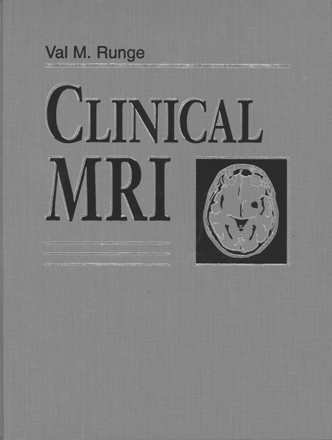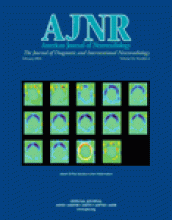Val M. Runge. Elsevier Science; 504 pages, 1597 illustrations. $85.
Clinical MRI, a book with 492 pages, devotes 116 pages to the brain, 110 to the spine, and 53 to the head and neck. That amount is not really long enough to cover the brain in any detail. In this review, I limit my comments to the neuroradiology section of the book.
Even though this book was first published in 2002, it seems that it was written a decade ago. The author spends a lot of time on issues that were pertinent 10 to 15 years ago but are clearly resolved now. For example, they often compare CT and MR imaging of different pathologic abnormalities of the brain. First of all, I am not sure what place discussions about CT have in a book on MR imaging. Second, why not spend more time on interesting new aspects of MR imaging? Most of the interesting innovations in MR imaging, such as spectroscopy, functional MR imaging, and diffusion tractography, are not even mentioned.

A limited discussion of diffusion and perfusion is presented. Discussion of diffusion MR imaging is very short (pages 49 and 50). Therefore, for those who know the subject, it is superficial. For those who do not know the subject, it adds very little to their understanding of this topic. You have to know something about the physics of water molecules to understand what is happening to the signal intensities. For example, what makes the difference between diffusion-weighted images and apparent diffusion coefficient maps is not even addressed. In addition, there are a number of factual errors. The author claims that cytotoxic edema is “not detectable” on a T2-weighted image. Also, the author claims that pseudonormalization (for some reason called supranormal by the author) of the apparent diffusion coefficient values after an acute stroke “is a current area of study” occurring between 24 hours and 10 days after the stroke. In actuality, it has been known for some time that in the clinical setting for humans, pseudonormalization occurs at approximately 2 weeks.
Some passages look as though they have been adapted from past editions and not even edited to reflect changes that have occurred during the past 10 years. For example, “A third category, inversion recovery, also exists. However, scans of this type are used much less frequently.” I am sure that fluid-attenuated inversion recovery imaging is used rather frequently by most practices. The author actually proceeds to discuss fluid-attenuated inversion recovery imaging later on the same page (page 2).
The quality of the images ranges from barely passable to unacceptable. Most appear as though they had been done on a low-field-strength system and then filtered. Figure 8-5 is just horrible. Some images are rather fuzzy, such as Figures 1-18A and 9-7. Certainly, a better example of meningeal carcinomatosis can be found than Figure 1-30. The best way to differentiate dermoid-epidermoid from an arachnoid cyst is by diffusion. This is not mentioned.
Occasionally, a lot of space is spent on topics that are obvious to most readers. For example, a long paragraph is spent on why MR imaging is better than CT for imaging the pituitary gland (page 21). Certainly, in a short book, space can be better spent. By the way, this discussion also contains a clear inaccuracy: “Dental amalgam causes no artifacts.”
Perfusion is discussed in the last two sentences of the chapter on brain tumors (page 27). I would venture to say that two sentences are not enough. If the reader is familiar with perfusion, s/he will take issue with the first sentence. If s/he is not, then two sentences hardly do justice to the topic. The topic is much more complicated than what is suggested by the author (1, 2).
The author states, “CT is positive for infarction in only about 20% of patients within the first 6 hours.” This is true for CT as it was performed in 1980. Clearly, there have been advances (3, 4). I am not even speaking about more advanced topics, such as CT perfusion (which the author does not even mention). A debate exists regarding whether CT or MR imaging is better in cases of acute stroke in terms of thrombolytic therapy. Both sides have merit. This is an issue about which radiologists can make a big difference in patient management, yet this issue is not discussed in the book.
The section on small-vessel disease contains factual errors. The authors contend that the areas of T2 hyperintensity are caused by ischemia and infarction. This is clearly not the case, as shown by many authors, most notably Ajax George’s group at New York University during the 1980s (5). For something to be called an infarction, a T1 abnormality must be present; otherwise, the lesion should be called leukoencephalopathy. Golomb et at (and others) have shown that the lesions are different pathologically.
The only “atrophic” brain diseases mentioned are Huntington disease, central pontine myelinolysis, and “cerebellar degenerative disease.” I found it stunning that normal aging of the brain, Alzheimer disease, and Parkinson disease are not even mentioned. Far less common diseases, however, such as Leigh, Canavan, Hurler, and olivopontocerebellar atrophy, are mentioned.
The book is not well organized. Many topics are discussed several times in the book. Chiari malformations are discussed in the brain and C-spine sections (rather extensively, as this book goes: pages 98–100 and 121–123). Neurofibromas, meningiomas, astrocytomas, metastases, disk herniations, and multiple sclerosis are discussed in both the C-spine and the T-spine sections. Some of these entities are discussed for a third time in the L-spine section. This seems to be a colossal waste of space, considering that more important topics are not addressed.
In summary, from a neuroradiologist’s point of view, I cannot recommend Clinical MRI to any group. Because it contains insufficient information, factual errors, and many substandard images, it would be of little use to residents, fellows, or practicing neuroradiologists.
- Copyright © American Society of Neuroradiology












